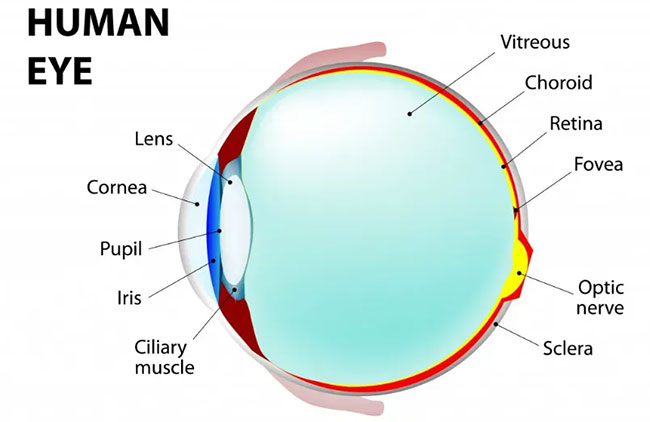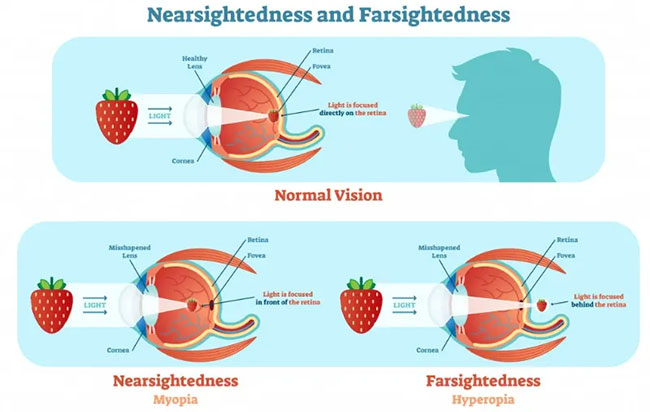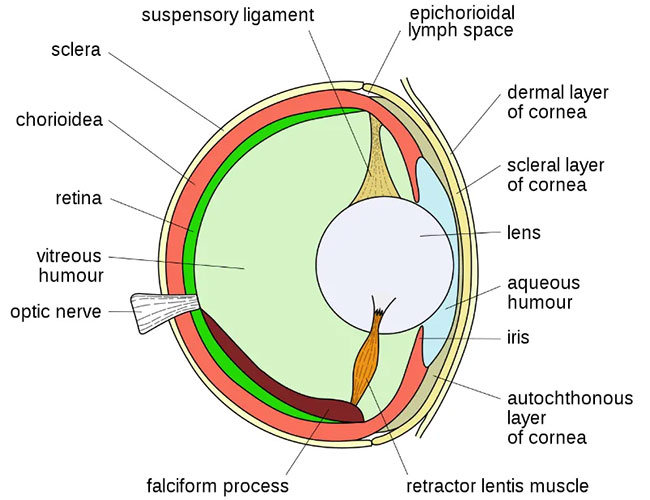The spherical lens in fish eyes compensates for refractive deficiencies, allowing for better image focus on the fovea – the area of sharp vision.
Have you ever dived underwater and tried to open your eyes to observe everything around you, only to see blurry and indistinct images? You might wonder if fish see everything in a similar way or if they have specialized methods for seeing underwater. It’s not entirely the same; to help us understand how fish eyes work, let’s explore this topic through the lenses of anatomy, evolution, and optics.
The eye is a highly complex structure with intricate functions. The basic structure and function of the eye are somewhat similar across all vertebrates. This structure took less than 100 million years to evolve. In this article, we will focus on three fundamental components — the lens, vitreous humor (the gel-like substance behind the eye), and the fovea (the visual pit). As light passes through the eye, it also travels through the aqueous humor — a water-like fluid, while the lens helps focus light onto the fovea. The fovea is the part of the eye where sharp images are formed; in other words, it is the area that allows us to see clearly.

The complex structure of an eye.
Seeing underwater is very different from how we see on land:
- Firstly, water absorbs light more than air. This makes everything darker as you dive deeper underwater. In this thought experiment, we will only consider vision at a depth of 80 meters, as light does not penetrate below that point.
- Secondly, water absorbs red light the most, followed by orange, yellow, green, and then blue. This means that everything underwater will appear slightly “bluer.” The deeper you go, the more pronounced the blue hue becomes.
However, that is not the only property of light underwater; let’s continue exploring the characteristics that make everything appear somewhat blurry.
To understand this better, we will investigate two issues – the physics of light and the anatomy of the eye. Specifically, we will look at how light behaves when it is underwater. Water is denser than air, so light travels slower underwater. While this slight difference in time is almost imperceptible, it has other implications.
A common term you might hear in optics is refraction. Refraction refers to the phenomenon of light changing direction as it passes through the interface between two transparent media with different refractive indices. An example is when light travels from air into water. This is why a pencil appears bent or broken when you place it in water.

When light converges at a specific point in the eye, it creates a sharp image.
When light travels from a less dense medium to a denser one, it undergoes convergence. When light converges at a specific point in the eye, it creates a sharp image, which is facilitated by the lens. The lens works by converging light. For a clear image, light must converge precisely at the fovea. If light is not focused on the fovea, it will result in a blurry image.
When underwater, light entering the eye must be refracted sufficiently to focus on the fovea. If light is not refracted enough, everything will appear blurry, similar to the condition known as hyperopia in humans. The diagram below illustrates the effects of visual defects, helping you understand where light focuses when it is insufficiently refracted.

Effects of visual defects
When light enters the eye in an underwater environment, it will not be refracted significantly. This is because the density of the lens and water are very similar. At this point, the role of the lens in the eye becomes crucial; a denser lens refracts light more effectively. The lens, being quite rounded, allows light to travel through it over a greater distance, thus refracting it more effectively. This ensures that light converges at the correct point. If the lens were flatter, it would not converge correctly, as described earlier.

Spherical lens in a fish’s eye
Another reason is that the angle at which light passes through the lens is larger due to the curved surface of the lens. According to the law of refraction, it will refract light better, allowing for more concentrated light. This ensures that light converges at the correct point. If the lens were flatter, it would not converge correctly, as previously mentioned.
The spherical lens also has the ability to curve images, so fish tend to observe their surroundings with slightly distorted images, but this actually provides them with a wider field of view.
 Image depicting the view from a fish lens, everything appears curved and tilted, but you gain a wider field of view
Image depicting the view from a fish lens, everything appears curved and tilted, but you gain a wider field of view
Humans and other terrestrial animals have flatter lenses because they help us focus in an air environment, while fish have rounder lenses to help them focus underwater. This is a remarkable adaptation for fish. Vision in fish is highly evolved and complex, but in reality, terrestrial animals have adapted even more impressively. Fish eyes and lenses are often likened to a “blueprint”.


















































